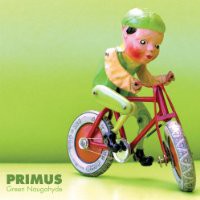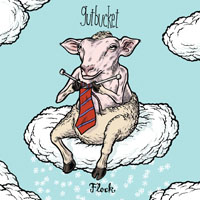 Shining: One One One (Prosthetic / Universal Norway, 5/28/13)
Shining: One One One (Prosthetic / Universal Norway, 5/28/13)
There are covers, and then there are covers. Shining’s version of King Crimson’s “21st Century Schizoid Man” is the latter, a roiling, screaming beast of wails, beats, and static.
 Shining: One One One (Prosthetic / Universal Norway, 5/28/13)
Shining: One One One (Prosthetic / Universal Norway, 5/28/13)
There are covers, and then there are covers. Shining’s version of King Crimson’s “21st Century Schizoid Man” is the latter, a roiling, screaming beast of wails, beats, and static.
In just one more trip around the sun, another swarm of immensely talented but under-recognized musicians has harnessed its collective talents and discharged its creations into the void. This list is but one fraction of those dedicated individuals who caught our ears with some serious jams.
[Chromatic, our 400-page exploration of musicians and color, is out now. Order here!]
 Primus: Green Naugahyde (ATO / Prawn Song, 9/13/11)
Primus: Green Naugahyde (ATO / Prawn Song, 9/13/11)
Primus: “Tragedy’s a’Comin'”
[audio:https://alarm-magazine.com/wp-content/uploads/2011/09/Primus_Tragedys_AComin.mp3|titles=Primus: “Tragedy’s a’Comin”]“It’s kind of like trying to describe a wine,” chuckles Primus bandleader/bassist Les Claypool. “Everybody has their different adjectives that they use.”
Responding to the suggestion that the oddball Bay Area trio’s new album, Green Naugahyde, was recorded and mixed with a more transparent “sound” than previous work, Claypool doesn’t necessarily agree or disagree. The album is the band’s first full-length in 12 years, and listeners, of course, are bound to draw their own conclusions.
“Whatever ‘transparent’ means to you,” he continues, “might be different than what it means to me. From a production standpoint, the approach to this thing was very similar to what we’ve always done, which is record ourselves at my house. Over the years, I’ve collected a bunch of old vintage gear — we recorded to tape through an old API console, so it’s a very clean, very crisp, very clear recording. And for the most part, we weren’t coloring things after the fact. It was going to tape as raw as we could possibly put it to tape. But there’s also a lot of contrast between the individual songs.”
Ancestors‘ tries its hand at “nerdy storytelling music” with Neptune with Fire, chronicling the mythological King Neptune’s burden of holding unlimited power.
 Gutbucket: Flock (Cuneiform, 2/22/11)
Gutbucket: Flock (Cuneiform, 2/22/11)
Gutbucket: “4 9 8”
[audio:https://alarm-magazine.com/wp-content/uploads/2011/02/03-4-9-8.mp3|titles=Gutbucket: “4 9 8”]Brooklyn-based jazz-rock quartet Gutbucket released its fifth album, Flock, in February on Cuneiform. The band takes its name from the term “gutbucket,” which means to play jazz in a particularly exuberant or expressive style, and it claims that its unconventional style has been “injecting a shot of glorious spazmitude into the minimalist cool of the New York downtown scene” for the past 10 years.
Gutbucket’s off-the-wall music is the result of its members’ distinct contributions and, inevitably, artistic disagreements and compromises. When it comes to food, Gutbucket engages in a similar, hotly contested discourse. So whet your appetite and embrace the taste-bud-inspired tongue lashings with Gutbucket’s culinary treatise, “How to Argue About Food.”
How to Argue About Food
by Gutbucket
Most bands break up. It’s a fact. Rock bands do this quite a bit, and it’s often not very friendly. Jazz bands might be a bit more civil about it, or perhaps not. If you’re reading this, chances are you’ve been in a band before, so this is not unfamiliar terrain.
Take three or more humans engaged in a creative endeavor, and ideas, visions, aesthetics, and more will clash. So how do you handle this?
Well, Gutbucket has the answer.
Forget about consensus. Don’t pretend you will agree. Embrace the friction, disagreement, discomfort, and argumentative spirit.
But please have other outlets and arenas besides your music in which to behave this way.
That’s why Gutbucket chooses to argue, debate, dissect, and regularly disagree about food. Yes, food. We are a band of music nerds who spend most of our time talking about food instead of music.
 Jono El Grande: Phantom Stimulance (Rune Grammofon, 2/1/11)
Jono El Grande: Phantom Stimulance (Rune Grammofon, 2/1/11)
Jono El Grande: “Borrelia Boogie”
[audio:https://alarm-magazine.com/wp-content/uploads/2011/02/Jono_El_Grande_Borrelia_Boogie.mp3|titles=Jono El Grande: “Borrelia Boogie”]The off-kilter art rock of Norwegian bandleader, composer, singer, guitarist, and kazoo player Jono El Grande is like candy to fans of Frank Zappa and whimsical, progressive rock. In his 10 years of playing with The Luxury Band (née The Jono El Grande Orchestra), he has released four albums, including the multi-layered Neo-Dada in 2009 and the raucous Phantom Stimulance this winter.
Though he has enjoyed success in his native Norway, Jono’s delightfully eccentric music isn’t yet as well known overseas. Here he opens up about composing, why there’s no such thing as a “live favorite,” and how songs can take more than a decade to record.
According to your label, only one song on your newest record, Phantom Stimulance, is newly composed, with the rest being unreleased live favorites, compiled to commemorate your 10 years as a bandleader and 15 as a composer. Why did you decide to record these songs to celebrate this occasion?
There are two brand-new compositions on the album, not one — “Borrelia Boogie” and “Rise Of The Baseless Press-Base Toy.” The other songs are completely rearranged versions of songs that never reached an album and new arrangements of earlier-released songs that have evolved so much on stage during the years that they deserved to be released again, with new titles. “Live favorites” is a term that the record company came up with. Even if this record is presented as an anniversary, it is nevertheless the music that is most important. Always.
Why hadn’t the songs on Phantom Stimulance been recorded previously? Were they more suited to live performance than the studio? Are there any live favorites still yet to be recorded?
I am a composer who likes to develop compositions over time at live shows by adding new themes and parts to them. My working process is very often like this: I write the basic scores at home, then the band rehearses the music, and then we play the material live and mold it until I feel that it is ready to be recorded. And I never know exactly when each song is ready. The reason why these tracks haven’t been recorded previously is that, on earlier albums, there were other compositions that I felt were more ready than ones on Phantom Stimulance. You may call them “live favorites” — to me these tunes were the hard ones, the ones that I had to work a little extra with to make them worthy to be immortalized on an album. We used 40 to 60 tracks on each song. “La Dolce Vidda” contains 10 drum tracks, I think.
It was actually quite the same with Neo-Dada. Some compositions there date back to the ’90s. And to the last question: yes, there will be more “live favorites” to be released in the future. I just have to compose them first.
For British guitarist Matt Stevens, the widespread digital distribution of his music via the Internet has meant more than major labels and pricey CDs ever could.
The members of Krallice come from a variety of backgrounds — math metal, punk jazz, death metal — but their outgrowth of black metal in a community where the genre is lacking is reminiscent of the jazz era, when new sounds were pouring out of Queens, NY.
Brooklyn’s La Otracina has been surfing the “new wave of psychedelic heavy metal” for seven years, impressing with its powerful style and inspiriting live shows. Now, be on the lookout for added vocals and a new line-up on its upcoming album, Reality Has Got to Die (Holy Mountain) out September 21.
Californian stoner-metal duo Black Cobra discusses the perks and difficulties of maintaining a band with a long-distance relationship. With 400 shows in merely three years under its belt, the band has turned heads with its raw sound and in-your-face attitude.
Scott Rosenberg of P.A.F. fame brought together a motley crew of musicians to form Pink Mountain. What resulted was something no one could have expected: a sprawling twelve-song marriage of psych, prog, krautrock and freeform jazz that is fueled by a synergistic array of influences.